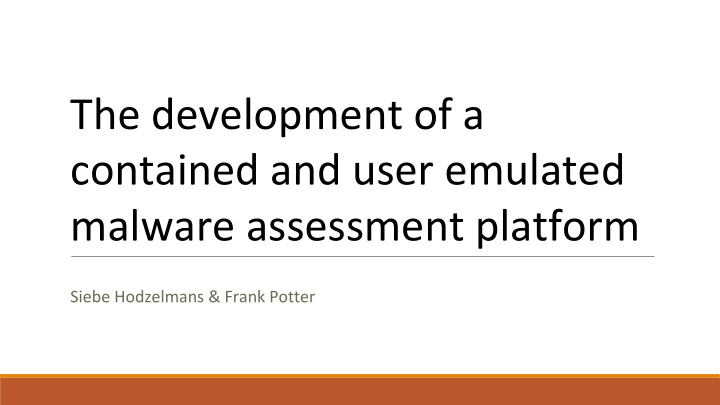



The development of a contained and user emulated malware assessment platform Siebe Hodzelmans & Frank Potter
(TechCrunch, 2012) 2/23
Incident Response and Malware Analysis (Debrie, Lone-Sang, and Quint, 2014) 3/23
(ArsTechnica, 2017) 4/23
(Times Square Chronicles, 2019) 5/23
Research ques+on ‘How can malware be tested for detection of antivirus software by emulating user actions, without the AV vendor learning about the malware?’ 6/23
Sub questions ● What traffic is generated by AV software? ● How to prevent AV software from notifying and submitting the red team’s malware to the AV vendor? ● Are there any differences between direct scanning and user emulated detection rates? 7/23
Methodology - Traffic analysis ● McAfee, Symantec and Trend Micro ● Malware samples 8/23
9/23
Methodology - Preventing submission 10/23
11/23
Methodology - User emulation ● Compare manual with emulated behavior of malware ● Web browsing user emulation with pywinauto and pyautogui ● Malware infection Tree (Kamali, 2016) 12/23
Results - Traffic analysis ● Traffic capture: ○ McAfee, Symantec and Trend Micro ○ Later Kaspersky ● In general: ○ Installation, registration, updating ○ Analytical data ○ Lots of hashes and encoded data ○ Only HTTP(S) 13/23
Results - Traffic analysis ● Noteworthy: ○ Trend Micro: missing SNI, long plain HTTP GET ○ McAfee: every file gets hashed, google analytics ○ Symantec: ping submission with data buffer ○ Kaspersky: lot of HTTP(S) 400 and 502 errors, certificate pinning ● No sample submission 14/23
Results - Traffic analysis Das Malwerk Deloitte obfuscated Deloitte direct exports 1e84- 1f7b- 230a- 266a- 2578- obf. obf. dll obf. dll beacon beacon msf ff45 55c7 6f87 11f5 6c51 exe 1 2 exe dll vnm ✔ ✔ ✔ ✔ ✔ McAfee ✔ ✔ ✔ ✔ ✔ ✔ ✔ ✔ Symantec ✖ ✔ ✔ ✔ ✔ ✔ Trend Micro ✔ ✔ ✔ ✔ ✔ ✔ ✔ ✔ ✔ Kaspersky 15/23
Results - Sample submission preven3on ● Offline: undesirable ○ Difference Trend Micro ○ Warning Symantec ● Blacklisting ○ Unsure what to block ○ Updates can change endpoints ● Whitelisting ○ Robust ○ Parameters: ■ hostnames ■ traffic size and direction ■ content 16/23
Results - User emulation ● Two ways: ○ pywinauto, accessibility API ○ pyautogui, mouse and keyboard, screenshots ● Compared manual to emulation ○ Malware infection Tree ○ File handles, process tree structure 17/23
Results - User emulation 18/23
Results - User emula-on 19/23
Discussion ● Contamination of packet captures ● mitmproxy ○ Insecure connections ○ Kaspersky errors ● Results of sample submission prevention ○ Unable to trigger sample submission ○ Flaw in research design ○ Based on what we did observe ● McAfee low detection rate 20/23
Conclusion How can malware be ● Variety of traffic tested for detection ○ But no sample submission of antivirus software ● Whitelisting the best approach by emulating user actions, without the ● Dynamic analysis is of added value AV vendor learning ○ User emulation matches manual about the malware? ○ Multiple approaches to emulation 21/23
Future work ● Exploratory investigation in traffic generated by AV software ○ Another approach: reverse engineering ● Combine whitelisting with IRMA ● Monitoring AV detection of malware 22/23
Questions? 23/23
Recommend
More recommend